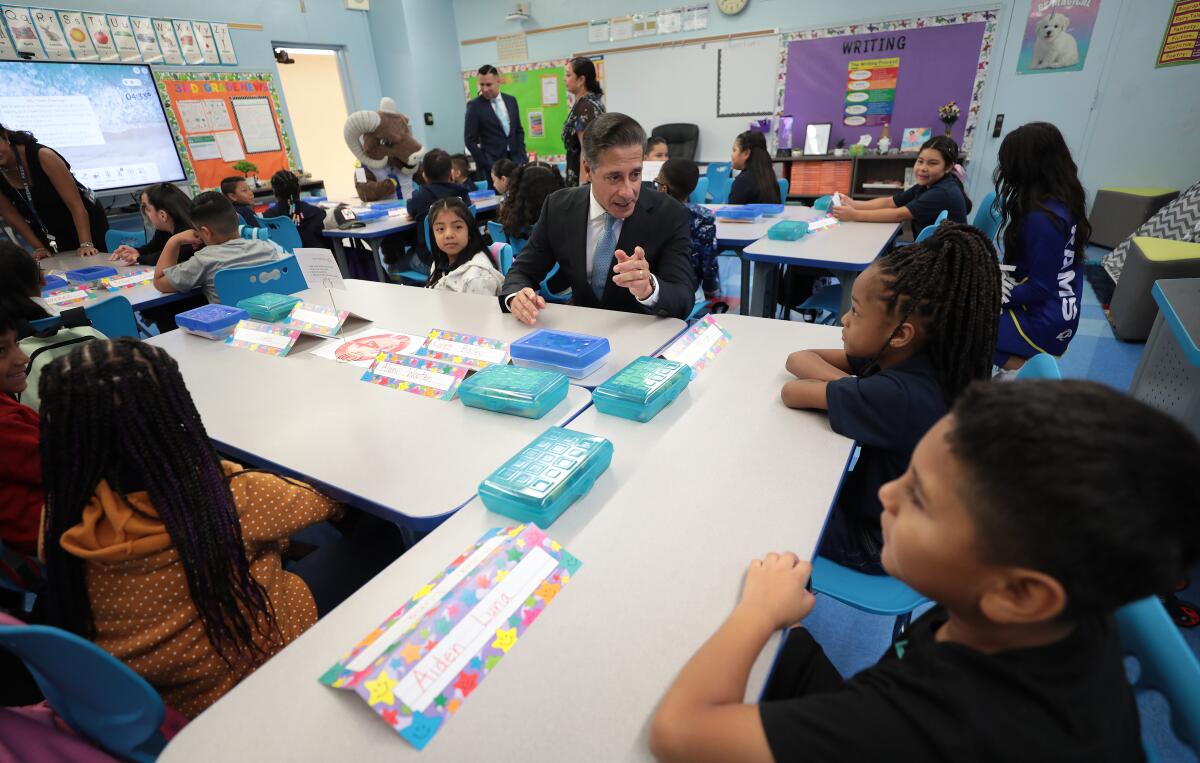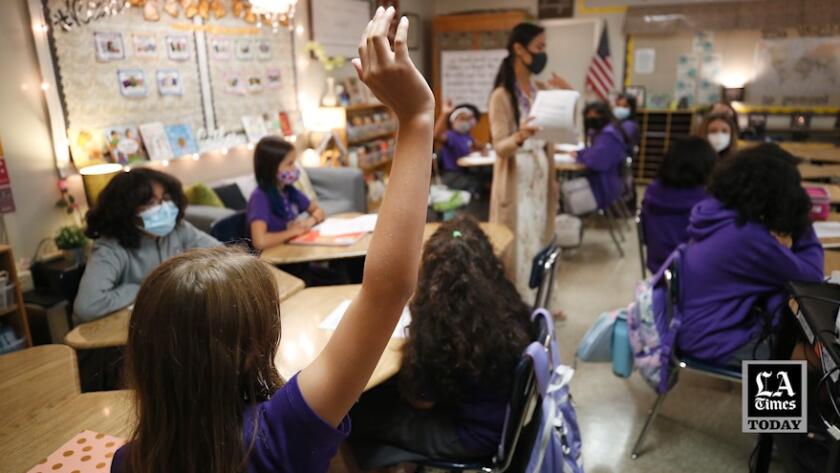Test scores show L.A. students still struggling to recover from pandemic setbacks

Los Angeles Unified students continue to struggle from pandemic learning setbacks, state test scores show, with modest progress in math, but largely flat or slightly declining results in English.
In math, the overall scores rose by 2 percentage points, with 30.5% of all students meeting or exceeding learning goals set by the state and measured in testing that took place in the spring, according to data released by the school district Tuesday. This means about 7 in 10 students do not meet standards.
Achievement gaps continue to be a problem. Although scores for Black students improved, only 19% met the learning standards in math. About 7% of district students are Black. Latinos make up about 3 in 4 students; about 24% met learning standards.
L.A. schools Supt. Alberto Carvalho said he is pleased that the percentage of students who met learning standards in math rose at all grade levels that take part in the state tests. The tests are administered in grades three through eight and grade 11.
“We are making progress, particularly in mathematics,” Carvalho said. “We put a lot of resources and efforts in mathematics.”
Supporters say proposed state K-12 framework will make higher-level math accessible to more. Critics contend it will make poor math outcomes worse.
State Board of Education President Linda Darling-Hammond said that in general, math scores have been more volatile during and after the pandemic. It was simply harder for students to learn math when campuses were closed during the worst of the COVID-19 pandemic, she said.
“Traditionally, math scores are more responsive to school factors than English language arts scores, because kids don’t tend to use math outside of school,” Darling-Hammond said. “When we were in the pandemic years, math scores dropped further” than English scores.
Conversely, she added, it would make sense that math scores would show more of a rebound: “So that piece makes sense.”
Statewide test results will be made public Wednesday, but individual school systems, such as L.A. Unified, have been authorized to release their results if they chose to.
Even with the improvement, L.A. Unified math scores still were below levels from the 2017-18 school year, two years before the pandemic resulted in campus closures.
The same is true for English scores, which were slightly down overall compared with last year, with 41.2% of students meeting standards. Among all district students, scores dropped by half a percentage point.
There were bright spots, with incremental gains in grades three, four and 11. In an interview, Carvalho said the 11th-grade scores seemed like an anomaly — welcome news, but difficult to explain and perhaps not meaningful in the big picture.
The progress in grades three and four could represent the success of one-on-one and small-group instruction that focused especially on the early grades.
L.A. Unified Supt. Alberto Carvalho said the program that will replace the lauded Primary Promise is more equitable and effective, while costing far less.
Some parents and teachers will see the results for younger students as vindicating their defense of Primary Promise, an intensive and high-cost reading and math program that focused on the early elementary grades. Two former school district superintendents had stepped forward to defend the program when Carvalho made it clear he would go in a different direction.
Carvalho did not deny that Primary Promise had benefits, but said the overall results justify his decision to redistribute resources to also reach more older students. They too need added support, he said.
More limited support for older students could have been a factor in the declining scores of these students, Carvalho said.
Regarding those declining scores, “I attribute that 100% to two factors: still the lingering effects of the pandemic, the learning loss. Secondly, the fact that the district had a reading strategy that was focused in such a narrow bandwidth,” Carvalho said in an interview.
He added that he also was concerned that the benefits from Primary Promise would fade over time without ongoing intervention support for older students.
Carvalho did not back down from his earlier pledge to recover from the pandemic in two years, promising “explosive” growth in reading test scores.
The district’s presentation outlined various ways in which students are being helped, including teacher training and improved instructional materials and student assessments.
School districts across California have received billions of dollars to address pandemic learning setbacks — with uncertain benefits.
The L.A. school board in June approved an $18.8-billion budget that included the last major tranche of pandemic aid — which will disappear in future years.
Darling-Hammond said the benefits from such aid have been reaching students gradually over the last couple of years, and she is hopeful that student achievement will soon show strong results from it.
Watch L.A. Times Today at 7 p.m. on Spectrum News 1 on Channel 1 or live stream on the Spectrum News App. Palos Verdes Peninsula and Orange County viewers can watch on Cox Systems on channel 99.
More to Read
Sign up for Essential California
The most important California stories and recommendations in your inbox every morning.
You may occasionally receive promotional content from the Los Angeles Times.














